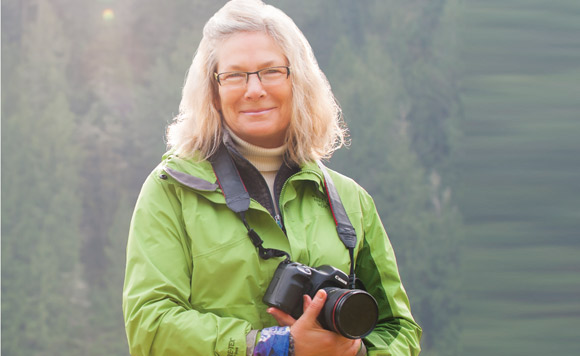As a Fine Arts teacher at the University of Victoria and an artist with a long career, you’ve worked in many media. You’ve done a 10- by 10-foot piece called “Inventory III: Requiem,” 25 paintings of leaves from around the world. Some might view it as a beautiful piece, while others may see it as a dark work with the “requiem” in the title (the extinction of leaves due to pesticides and environmental degradation). How are you able to create works with various levels of meanings?
Contemporary visual artists create works that operate on various levels as a natural consequence of their own art practice. This applies to any artist: musician, composer, playwright, dancer, choreographer, etc. After many years of working, an artist builds upon a repertoire of ideas, ways of working, emotions and even influences. These layers are usually seamless (invisible) to the average viewer and it is only with real interest in the subject, the artist or the medium, that the viewer goes deeper. Just as I might attend a respected dance company’s performance and enjoy it, I wouldn’t necessarily be aware of the history of the choreographer, what period in her life this piece was created, how some of the movements broke away from traditional practice, what influences she was embracing or breaking away from. Art in all forms strives at times to challenge the viewer’s assumptions, and can also make us feel quite uncomfortable.
You created an installation in 2001 called “Email: Tod Inlet” which was 10 feet by 15 feet and made of transparent fabric called toile which cascaded from high on a gallery wall to the floor. It was an email to a friend in Germany about a winter’s day at Tod Inlet – each word stitched by a digital sewing machine onto small pieces of the same fabric. Can you describe the evolution of this creation to photo essay to a book full of history and stories of Tod Inlet?
This is a difficult question, as my own creative process is a bit of a mystery to me.
As strange as it may sound, I had forgotten about this piece when I began my photo essay at Tod Inlet in 2006. One observation is that my artwork had been as much about words as imagery for many years. I didn’t question this as a valid way of working in my artwork, although I had always been a voracious reader and loved good writing. Perhaps more of a thread to the evolution to the book can be seen in my travels and rediscovery of the camera.
I have been fortunate to have experienced many wilderness journeys, and two in particular north of the 60th parallel in Canada probably had an influence. The first was a canoe/rafting journey down the length of the Bonnet Plume River in the northern Yukon and the second was a very different experience on the tundra hundreds of miles east of Yellowknife. Both were scenic in the extreme and the landscape, whether appreciated on a microscopic level or the expansive views from mountain ranges, was overwhelming. The tundra trip included well-known photographers who were flown in to this remote tent camp to capture images of musk ox and caribou. I was a tagalong artist, generously invited by the late photographer, Courtenay Milne. My initiation back to enduring interest was in the rich minutae on the ground: bleached bones of animals in the red bearberry covering the ground, white sand eskers with thousands of bird and mammal footprints ringing the clear lakes. I upgraded my camera equipment soon after returning home.
How do the many protagonists of this story (First Nations, industry, tourism, environmentalists) fit together in your book?
Hopefully, there is a flow between these subjects, but this was the most difficult part of writing the book. In a manuscript writing/editing workshop at the Banff Centre we were asked to draw an image of the flow of our work. Mine was a meandering pathway with short detours branching off. My walks through the seasons were a natural way to accomplish this. On a more literal level, the question might be “How do these different subjects rub shoulders with one another?” In my mind Tod Inlet is an entity or a spirit that has experienced many things, and these various subjects are a tiny part of Tod Inlet’s consciousness.
What are the important messages you hope people will come away with after reading “TOD INLET, A Healing Place?”
I will limit this to three thoughts. Firstly, the importance to all of us of the healing qualities of a walk in the woods and by extension, our need to respect all that exists there. Secondly, the understanding of First Nations’ cultural stewardship of this land and something of the price they have paid historically. Thirdly, the ongoing community spirit of our Peninsula environmental groups who have worked for decades as volunteers to revitalize our streams, ocean and forests.
Do you think there’s something essentially empathetic about women that traditionally makes them the teller of these stories?
I think women as a whole have had the luxury of expressing their feelings for nature and animals, but I think there are a lot of descriptive and moving books that have been written by men (from Thoreau to modern-day Craig Childs).
This is your first book; how did you find the publishing process?
I found it to be quite impersonal. My publisher is a man of his times – thoroughly digital. When I first met Don at a coffee shop in Cook Street Village to sign the contract, his parting words were (admittedly with a charming smile) that this would probably be the last time I would see anyone in person! It was true – a bit daunting for an older first-time author with a very complex set of decisions ahead and only email as a contact. But that is the way of publishing today. Now that I’ve been through the fire, I’m eager to do it again.
What’s next? Is there another area of the Peninsula of which you could imagine making the same sort of careful study?
Tod Inlet was a unique set of circumstances that came together. I’m currently working on non-fiction works loosely based on travel and the natural world.
Photo by www.nuttycake.com.




